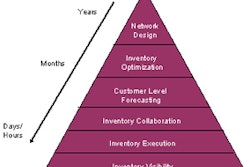The summer of 2008 may forever be known as the summer of the "staycation," when Americans decided that gas was too expensive to leave town for the annual summer trip. Companies around the world, suddenly faced with skyrocketing transportation costs, scrambled for cover as well, looking for any and every opportunity to cut costs and cope with rising fuel expenditures. And just when it seemed as if it couldn't possibly get any worse, the financial markets crumbled. With hands in the air, companies of all stripes asking, "What next?" and "How can I prepare?"
In truth, so many factors affect oil prices — currency fluctuations, politics, speculation, and crumbling banking and credit systems — that no one could accurately predict which way the market would go. However, instead of being left to shrug your shoulders and say "What's next?" or "Who knew this was going to happen?", companies need to be prepared for a dynamic global market. By establishing a contingency plan and having answers to the "what ifs," an organization can be in a position to succeed regardless of what oil does or how various markets fluctuate or how the economy turns.
Unpredictable fuel costs are a fact of business — not just today, but always. Recent events have only drawn attention to a harsh reality that has, in fact, always existed. Even with prices dropping dramatically and potentially remaining static for an extended period of time, organizations would be foolish not to accept the dynamic nature of fuel as a long-term reality and seek opportunities for savings elsewhere to minimize the impact that fuel costs have on their bottom line.
The good news, however, is that a best-practice approach can help any organization that utilizes fuel to stabilize their business and remain competitive amid drastic price fluctuations.
In fact, current economic conditions have led to a softened transportation market, offering companies numerous opportunities to leverage the increased levels of competition to their benefit. Suppliers want to keep their current business, and therefore may be more flexible than one might think. Organizations that rely on LTL, truckload, air freight, ocean freight and small parcel shipping can take advantage of the softness in the transportation market to minimize the impact of rising fuel prices. Also, gaining visibility into accessorial charges (which have risen almost 900 percent in some modes of transportation such as small parcel in the last decade) and achieving a better understanding of freight surcharges will further enhance buyers' negotiating stance and enable them to reduce overall transportation spend.
The first step in positioning your company to remain steady in the face of highly erratic fuel costs involves obtaining a thorough understanding of transportation cost structures — i.e., the mix of labor, equipment, accessorial and fuel costs that your shippers incur. For instance, do you know the percentage that fuel contributes to your freight costs? That knowledge can be extremely important if you're trying to push back on any "fuel surcharges" your shippers are trying to levy, since those really should apply to only the portion of spend that is directly impacted by fuel prices. Or, you may want to look at recent emissions rules for trucks. How hard hit was your carrier's fleet? They may be using emissions as an excuse to squeeze you for a few more bucks. Whether or not this is the case, however, it pays to not only keep up with macro trends, but also understand how they directly impact your carriers.
Remember that at the end of the day your carriers need your business as much as you need their services. Therefore, you can work with your service providers to gain a better understanding of how fuel prices are impacting their cost structures. Acting in good faith to share the burden of price fluctuations can open opportunities to restructure contracts in an equitable manner and maintain long-term, mutually beneficial relationships. A careful review of contract terms may unlock potential savings opportunities that can positively impact your bottom line, and may pave the way for implementations such as a buyer-dictated fuel surcharge program that standardizes the price of fuel and requires carriers to focus on the cost of their core service.
Armed with a thorough understanding of transportation cost drivers, you can leverage that knowledge to pursue the following opportunities for bottom-line savings:
- Accessorial Charges — If you're commonly getting hit with accessorial charges (i.e. weekend delivery, wrong address or any of the other a-la-carte fees), now is a great time to revisit those costs with your suppliers. They may play hardball on freight rates, but this is an area where they may be more willing to negotiate.
- LTL Tariffs — With all of your vendors working off the same tariff schedule, you can truly compare costs and weigh your options.
- Consideration of Alternative Ports — Flexibility here will allow you to take advantage of shifting truck and rail capacity. And with some new routes coming online, you may have more cost effective routes to consider.
- Service Level Visibility — Are mavericks in your organization running up bills by shipping next-day a.m. when it could go two-day ground? Without visibility into the premium services your company is using, you could be unnecessarily bleeding money on couriers. Try implementing a system that provides visibility into the actions of your employees and either flags or prevents unnecessary or unauthorized transactions.
- Demand Management — Understanding what is required in order to fulfill your customer obligations also provides opportunities for savings. For instance, are your just-in-time shipments actually being rushed due to over-zealous employees? Could you delay three LTL shipments 24 hours in order to fill one truckload? If so, you have an opportunity for greater efficiency and savings.
- Competitive Sourcing — While you can't competitively bid fuel, you may find opportunities for savings in the non-fuel components of your contracts. For instance, if you're buying a service that includes a fuel surcharge, break the charge out separately, tie it to an index that allows for fluctuation and then bid the rest of the cost of the service.
- Fuel Surcharges — Standardizing fuel surcharges across vendors will give you a level playing field to comparison shop. And reviewing it more frequently — say weekly, rather than monthly — will give you greater insight and leverage with your shippers. Fuel surcharges are an area where carriers have leeway to negotiate. In a time of dubious cartel behavior, different surcharge tables, different surcharge pricing models and changing commission incentives for forwarders, you should be in a strong position to make your case internally if management still isn't onboard and with your carriers, who likely have excess capacity and will do what it takes to keep your business.
Aside from transportation-related cost-savings, you can pursue other spend management tactics to offset fluctuations in fuel. For example, if you find you were unable to directly combat rising gas prices last year, begin looking for savings in other areas. You can offset the unpredictable dynamic by driving cost reductions in non-affected categories of spend such as temporary labor, IT and legal services or print marketing. You may be able to reduce commodity costs between five percent and fifteen percent by, among other things, increasing the frequency of sourcing events, leveraging tools that provide clear visibility into enterprise-wide spending and streamlining the accounts payable process to reduce invoicing over-charges. These savings will help offset rising energy-related costs.
Also, be sure to watch the markets. By constantly monitoring key indices and market developments, you can proactively manage the impact of any changes on your contracts and re-evaluate them as appropriate.
Finally, keep in mind that there is no quick-fix solution for managing fluctuating commodity prices. Effectively combating their impact requires a sustained commitment on an enterprise-wide, global basis. But by implementing sound sourcing strategies and sticking to them, you can mitigate the risk for your company and lessen potentially negative effects on your businesses.
About the Author: Rachel Rutkoski is a category manager for Transportation and Logistics in Ariba's Global Services Organization. Rutkoski is recognized by the Institute for Supply Management as a Certified Professional in Supply Management (C.P.S.M.) and has several years experience as a supply chain and transportation analyst in Fortune 500 companies. Rutkoski regularly writes about transportation issues on Ariba's SupplyExcellence.com blog.



















